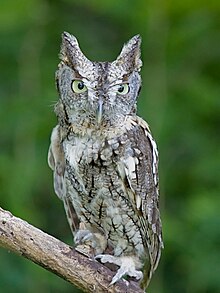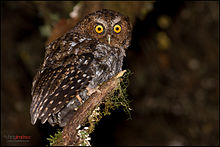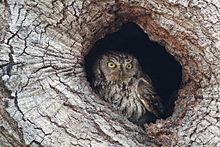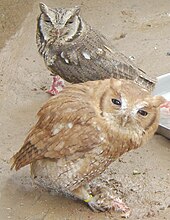Screech owl
Parts of this article (those related to screech owl evolution, taxonomy, and systematics) need to beupdated.(September 2019) |
| Screech owl Temporal range:Mioceneto present
| |
|---|---|

| |
| Eastern screech owl,Megascops asio Rufousmorph | |

| |
| Gray morph | |
| Scientific classification | |
| Domain: | Eukaryota |
| Kingdom: | Animalia |
| Phylum: | Chordata |
| Class: | Aves |
| Order: | Strigiformes |
| Family: | Strigidae |
| Genus: | Megascops Kaup,1848 |
| Type species | |
| Strix acio Linnaeus,1758
| |
| Species | |
|
Some 22, seetext | |
| Synonyms | |
|
MacabraCarlo Bonaparte, 1854 | |
Screech owlsaretypical owls(Strigidae) belonging to thegenusMegascopswith 22 livingspecies.For most of the 20th century, this genus was merged with theOld Worldscops owlsinOtus,but nowadays it is again considered separately based on a range ofbehavioral,biogeographical,morphological,andDNA sequencedata.
Screech owls are restricted to theAmericas.Some species formerly placed with them are now considered more distinct (seebelowfor details).

Description
[edit]Similar to other owls, the screech owl females are larger than the males of their species. They have a compact size and shape. They are small and agile, and about 7 to 10 inches tall and have a wingspan around 18 to 24 inches. They have prominent, wide-set feather tufts with bright yellow/green eyes. They have different brownish hues with whitish, patterned underside. This coloration helps them get camouflage against the tree bark.
Ecology and behavior
[edit]Screech owls hunt from perches in semiopen landscapes. They prefer areas that contain old trees with hollows; these are home to their prey, which includesinsects,reptiles,smallmammalssuch as bats and mice, and small birds. Screech owls have a good sense of hearing, which helps them locate their prey in any habitat. They also possess well-developed raptorial claws and a curved bill, both of which are used for tearing their prey into pieces small enough to swallow easily. They usually carry their prey back to their nests, presumably to guard against the chance of losing their meal to a larger raptor.
Screech owls are primarily solitary. During the late winter breeding season, however, males make nests in cavities, sometimes reusing abandoned nests of other animals, to try to attract females. The females select their mate based on the quality of the cavity and the food located inside. During the incubation period, the male feeds the female. These birds aremonogamous,with biparental care. The young of most screech owls arealtricialto semialtricial.[1]
Northern screech owls are found in eastern states, such asNew JerseyandNew York.The screech owls are named for their piercing calls. Their normal territorial call is not a hoot as with some owls, but a trill consisting of more than four individual calls per second given in rapid succession (although the sound does not resemble screeching or screaming). They also have a kind of "song"used in courtship, and as a duet, between members of a pair. Calls differ widely between species in type and pitch, and in the field are often the first indication of these birds' presence, as well as the most reliable means to distinguish between species. The distinctness of many species of screech owls was first realized when vastly differing calls of externally similar birds from adjacent regions were noted.
Evolution, taxonomy, and systematics
[edit]The genusMegascopswas introduced by German naturalistJohann Jakob Kaupin 1848.[2]Thetype speciesis theeastern screech owl(Megascops asio).[3]Theevolutionaryrelationships of the scops and screech owls are not entirely clear. What is certain is that they are very closely related; they may be consideredsister lineageswhich fill essentially the sameecological nichein theirallopatricranges. A screech owlfossilfrom theLate PlioceneofKansas[4](which is almost identical toeasternandwestern screech owls) indicates a longstanding presence of these birds in theAmericas,whilecoevalscops owl fossils very similar to theEurasian scops owlhave been found at S'Onix onMajorca.[5]The scops and screech owl lineage probably evolved at some time during theMiocene(like most other genera of typical owls), and the three (see below) modern lineages separated perhaps roughly 5 million years ago. Note, no reliable estimate of divergence time is known, asOtusandMegascopsareosteologicallyvery similar, as is to be expected from a group that has apparently conserved itsecomorphologysince before itsevolutionary radiation.Like almost all scops and screech owls today, their common ancestor was in all probability already a small owl, with ear tufts and at least the uppertarsus( "leg" ) feathered.
However that may be, the hypothesis that the group evolved from Old World stock[6]is tentatively supported bycytochromebsequencedata.[7][8]The screech owls also have a different placement of the procoracoid (less of ananteriorincline) andcoracoidbones compared to other New World owls.[9]
The splitting ofOtus sensu lato
[edit]
While late-19th-centuryornithologistsknew little of the variation of these birds, which often live in far-off places, with every newtaxondescribed a few differences between the Old and New World "scops" owls became more and more prominent. Namely, the scops owls give a whistling call or a row of high-pitched hoots with fewer than four individual hoots per second. This call is given in social interaction or when the owl tries to scare away other animals. The screech owls, though, are named for their piercing trills of more than four individual notes per second, and as noted above, they also have a kind of song, which is absent in the scops owls. A few other differences are seen, such as brown coloration below being common in scops owls and almost never seen in screech owls, but the difference in vocalizations is most striking.
By the mid-19th century,Otuswas becoming identified as encompassing more than one genus. First, in 1848, the screech owls were split off asMegascops.Subsequently, the highlyapomorphicwhite-throated screech owlof theAndeswas placed in themonotypicgenusMacabrain 1854.Gymnasiowas established in the same year for thePuerto Rican owl,and thebare-legged owl(or "Cuban screech owl" ) was separated inGymnoglauxthe following year; the latter genus was sometimes merged withGymnasioby later authors.

By the early 20th century, thelumping togetheroftaxahad come to be preferred. The third edition of theAmerican Ornithologists' Union(AOU) checklist in 1910, placed the screech owls back inOtus.Although this move was never unequivocally accepted, it was the dominant throughout most of the 20th century. In 1988, attempts to resolve this were made by re-establishing all those genera split some 140 years earlier atsubgenusrank insideOtus.[10]Still, the diversity and distinctness of the group failed to come together in a goodevolutionaryandphylogeneticpicture, and until the availability ofDNA sequencedata, this could not be resolved. In the mid- to late 1990s, preliminary studies ofmtDNAcytochromebacross a wide range of owls found that even the treatment as subgenera was probably unsustainable and suggested that most of the genera proposed around 1850 should be accepted.[7][8]Though some debate arose about the reliability of these findings at first,[11]they have been confirmed by subsequent studies. In 2003, the AOU formally accepted the genusMegascopsagain.[12]
The bare-legged owl was also confirmed as distinct enough to warrant separation in its own genus. Furthermore, the white-throated screech owl was recognized as part of an ancient lineage ofMegascops– including also thewhiskered screech owland thetropical screech owl,which previously were considered to be of unclear relationships – and indeed its call structure is not too dissimilar from the latter. Its distinct coloration, approximated in the southern whiskered screech owl (Megascops trichopsis mesamericanus), is thus likely the result of stronggenetic drift.
Additionally, a population of the tropical screech owl from northern Colombia has recently been proposed as the Santa Marta screech owl (Megascops gilesi) to theIOC.[13][14]
Species
[edit]

The genus contains 22 species:[15]
- Whiskered screech owl,Megascops trichopsis
- Bare-shanked screech owl,Megascops clarkii
- White-throated screech owl,Megascops albogularis
- Tropical screech owl,Megascops choliba
- Bearded screech owl,Megascops barbarus
- Pacific screech owl,Megascops cooperi
- Western screech owl,Megascops kennicottii
- Eastern screech owl,Megascops asio
- Balsas screech owl,Megascops seductus
- Alagoas screech owl,Megascops alagoensis– first described in 2021
- Middle American screech owl,Megascops guatemalae
- Vermiculated screech owl,Megascops guatemalae vermiculatus
- Koepcke's screech owl,Megascops koepckeae
- Rufescent screech owl,Megascops ingens
- Cinnamon screech owl,Megascops petersoni
- Cloud-forest screech owl,Megascops marshalli
- Yungas screech owl,Megascops hoyi
- Xingu screech owl,Megascops stangiae– first described in 2021
- Chocó screech owl,Megascops centralis– split fromM. guatemalae
- Foothill screech owl,Megascops roraimae– split fromM. guatemalae
- Long-tufted screech owl,Megascops sanctaecatarinae
- Santa Marta screech owl,Megascops gilesi– first described in 2017
- West Peruvian screech owl,Megascops roboratus
- Tawny-bellied screech owl,Megascops watsonii
- Black-capped screech owl,Megascops atricapilla
References
[edit]- ^Ehrlich, Paul R.; Dobkin, David S. & Wheye, Darryle (1988).The Birder's Handbook. A Field Guide to the Natural History of North American Birds.Touchstone, pp. 296–298,ISBN0671659898/
- ^Kaup, Johann Jakob(1848)."Uebersicht der Eulen (Strigidae)".Isis von Oken(in German). Cols. 753–774 [765,769].
- ^Dickinson, E.C.;Remsen, J.V. Jr.,eds. (2013).The Howard & Moore Complete Checklist of the Birds of the World, Volume 1: Non-passerines(4th ed.). Eastbourne, UK: Aves Press. p. 269.ISBN978-0-9568611-0-8.
- ^SpecimenUMMP50982, a partial leftcoracoidfrom Fox Canyon: Ford (1966).
- ^Mlíkovský, Jirí (2002).Cenozoic Birds of the World, Part 1: EuropeArchived2011-05-20 at theWayback Machine.Ninox Press, Prague.
- ^Johnson, David (2003).Owls in the Fossil Record.The owl pages.
- ^abHeidrich, Petra; König, Claus & Wink, Michael (1995)."Molecular phylogeny of the South AmericanOtus atricapilluscomplex (Aves Strigidae) inferred from nucleotide sequences of the mitochondrial cytochrome b gene "(PDF).Zeitschrift für Naturforschung C.50(3–4): 294–302.doi:10.1515/znc-1995-3-420.PMID7766262.S2CID28746107.
- ^abWink, Michael & Heidrich, Petra (1999).Molecular evolution and systematics of owls (Strigiformes).In:König, Claus; Weick, F. & Becking, J.H. (eds.)Owls: A guide to the owls of the world.pp.39–57. Yale University Press, New Haven.ISBN0-300-07920-6
- ^Ford, Norman L. (1966)."Fossil Owls From the Rexroad Fauna of the Upper Pliocene in Kansas"(PDF).Condor.68(5): 472–475.doi:10.2307/1365319.JSTOR1365319.
- ^Marshall, Joe T. & King, Ben (1988). GenusOtus.In:Amadon, Dean & Bull, J: Hawks and owls of the world: A distributional and taxonomic list.Proceedings of the Western Foundation of Vertebrate Zoology3:296–357
- ^"Proposal (#58): Elevate subgenusMegascops(New WorldOtus) to full generic status ".South American Classification Committee. 2003.Retrieved27 December2017.
- ^Banks, Richard C.; Cicero, Carla; Dunn, Jon L.; Kratter, Andrew W.; Rasmussen, Pamela C.; Remsen, J.V. Jr.; Rising, James D. & Stotz, Douglas F. (2003)."Forty-fourth supplement to the American Ornithologists' Union check-list of North American birds"(PDF).Auk.120(3): 923–931.doi:10.1642/0004-8038(2003)120[0923:fsttao]2.0.co;2.
- ^Krabbe, Niels K. (2017)."A new species ofMegascops(Strigidae) from the Sierra Nevada de Santa Marta, Colombia, with notes on voices of New World screech-owls "(PDF).Ornitología Colombiana.16:eA08.
- ^"Proposed Splits/Lumps « IOC World Bird List".worldbirdnames.org.Retrieved2018-01-28.
- ^Gill, Frank;Donsker, David;Rasmussen, Pamela,eds. (December 2023)."Owls".IOC World Bird List Version 14.1.International Ornithologists' Union.Retrieved8 March2024.
Further reading
[edit]- Dantas, S.M.; Weckstein, J.D.; Bates, J.M.; Krabbe, N.K.; Cadea, C.D.; Robbins, M.B.; Valderrama, E.; Aleixo, A. (2016)."Molecular systematics of the new world screech-owls (Megascops:Aves, Strigidae): biogeographic and taxonomic implications ".Molecular Phylogenetics and Evolution.94(Pt B): 626–634.doi:10.1016/j.ympev.2015.09.025.PMID26456003.
- Wink, Michael; El-Sayed, Abdel-Aziz; Sauer-Gürth, Hedi; Gonzalez, Javier (2009)."Molecular phylogeny of owls (Strigiformes) inferred from DNA sequences of the mitochondrial cytochromeband the nuclearRAG-1gene ".Ardea.97(4): 581–591.doi:10.5253/078.097.0425.S2CID55406064.

